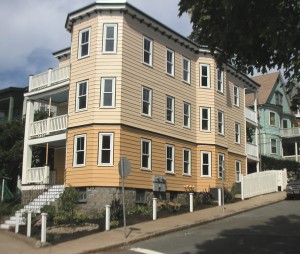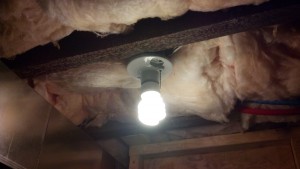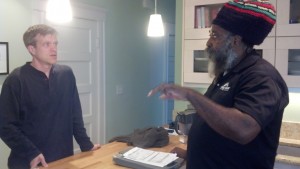When I was a little girl, I was convinced that a monster lived in my basement. I was afraid to go downstairs alone in the morning — this terrifyingly vivid image of the dining room floor opening up, and the Muppets ogre Sweetums climbing out.
Decades later as a first-time homeowner, I’ve learned that monsters are real. But instead of a big hairy guy, it’s zillions of microbes of mold that keep me up at night.
About two and a half years ago, I bought my condo in Somerville, Mass. — the middle unit in a restored 1895 triple decker. I was thrilled with the beautiful details, the
ENERGY STAR appliances, and the knowledge that the builders had taken great care to insulate and select high-efficiency windows and HVAC equipment.
There was just one problem: the very damp basement. The house sits on shale ledge; the foundation clearly needed repointing; the floor is essentially dirt. The builders assured me and my housemates, who bought our units within a few months of each other, that they’d never had a problem with mold.
“With these old houses, you just need to keep the basement windows open,” said John. It seemed logical enough. He pointed proudly to the French drain and the large sump pump in my storage unit, admitting that water would find its way through the porous walls.
We shrugged, resigned to the dampness that would never allow us to store much down there. I got oversized plastic bins and shelves from Home Depot for the things I couldn’t fit in my condo, and stacked them on the wooden pallets the builders had left for us.It was the first summer, in 2011, that we realized we had a problem.
The sheets of plywood the builders had used to build our three storage units were covered in dark greenish fuzz. “These things are like cotton candy for mold!” I proclaimed. We got the plywood out of there, sprayed everything we could with vinegar, and eventually tried a dehumidifier. The humidity didn’t drop noticeably, but our electric bill shot up about $100 a month.
After research and condo meetings, we went back to opening the windows, with the theory that air circulation was important. Somehow we made it through 2012 without many issues, thought the basement remained damp and musty. Life went on: the neighbors on the first floor had twins, Tom and I got married and agreed to stay in our city condo.
Then came the email as we prepared to head home from the 4
th of July holiday: “Condo Meeting: Urgent Mold,” wrote Brian from the third floor — a month before his own wedding. Uh oh. Tom and I returned from Vermont to see what the hot, humid weather had wrought on our basement.
It was bad. Really bad. Those latent spores had exploded – covering every surface with a nasty fuzz. The ceiling joists, the dirt floor itself, every bit of wood, plastic or metal where city soot had floated in the windows, providing a food source for our microbial guests.
There were actual mushrooms growing under the wooden pallets, along with a number of colorful fungal cousins. And so, over the past several weeks, we've been engaged in a flurry of research and consultations with air quality experts, mold remediation companies and duct cleaners. It looks like we are S.O.L. as far as any help from the insurance company. Together, our housemates have decided on a costly and multi-stepped plan to rid our home of mold (as best we can) and prevent it from taking up residence again.
The Number One Lesson: Keep Humidity Levels Below 45 percent.
Had our dear builders known or shared that maxim with us, we would never have had to learn about mold the hard way. No moisture, no mold. Seems obvious now. But how damp is too damp? We didn’t know until it was too late. It was hot, we were busy, and nobody had checked the basement in a few weeks. Silently, the monster was growing as we stayed cool in our condos upstairs.
Our windows-open method worked fine for years in an un-insulated house with a damp basement devoid of our personal belongings. Add three humming air conditioning systems, some insulation and the junk you’ve got nowhere else to put, and you’re going to have a problem. You know what happens when you bring a nice glass of ice tea outside on a hot day? It sweats. And it drips. That is essentially what happened with our duct work once we started running the AC — it rained inside.
Yes, my housemates and I have learned a whole lot. One of our biggest teachers was Sam Cohen from
Envirotest. Sam tested the air in the first floor unit and determined that yes, mold was making its way inside our homes through the duct work. That would all need to be professionally cleaned.
But first we need to install a serious dehumidifier and an air purifier, to dry out the air and keep all that city soot from providing a fresh substrate for mold. We are hiring a company to do the mold remediation, which involves antimicrobials, air cleaning and spraying a mold deterrent. All the fiberglass insulation installed in the basement ceiling last fall has to go, as does the saturated duct insulation.
Eventually, we’ll have
Mass Save back to do perimeter air sealing. And then there will be some sweat equity of our own. Our housemates have agreed we should prepare the basement floor and install a thin layer of concrete ourselves, as well as continue to patch up the foundation cracks where we can. (Kudos to Brian, who has already made this his hobby.)
We’ll also need to cover the French drain and the sump pump — those should
never be open, clucked the basement experts. This story is far from over — the $1,300 dehumidifier just arrived yesterday, and our housemate Mark is going to install it. Once things dry out and all remaining belongings are hauled out, the remediation begins.
We’ve got thousands more dollars and a lot more work to do to clean up the basement, protecting our investment and our health. I have to say I am thankful to have such great neighbors, as we all figure this out together. I only hope someone out there will remember our experience, avoiding their own tough lesson in building science.
 Sweetums seems much less scary now that I’ve met the monster called mold.
Sweetums seems much less scary now that I’ve met the monster called mold. A lovely home with a nasty problem.
A lovely home with a nasty problem. While the fiberglass insulation did not cause our problem, it does holds moisture close to the home’s wood framing, now covered in mold.
While the fiberglass insulation did not cause our problem, it does holds moisture close to the home’s wood framing, now covered in mold. Phil Addison, an inspector with Mass Save, checked out our basement and told my husband Tom Treat about some things we could do to limit moisture and air flow.
Phil Addison, an inspector with Mass Save, checked out our basement and told my husband Tom Treat about some things we could do to limit moisture and air flow.